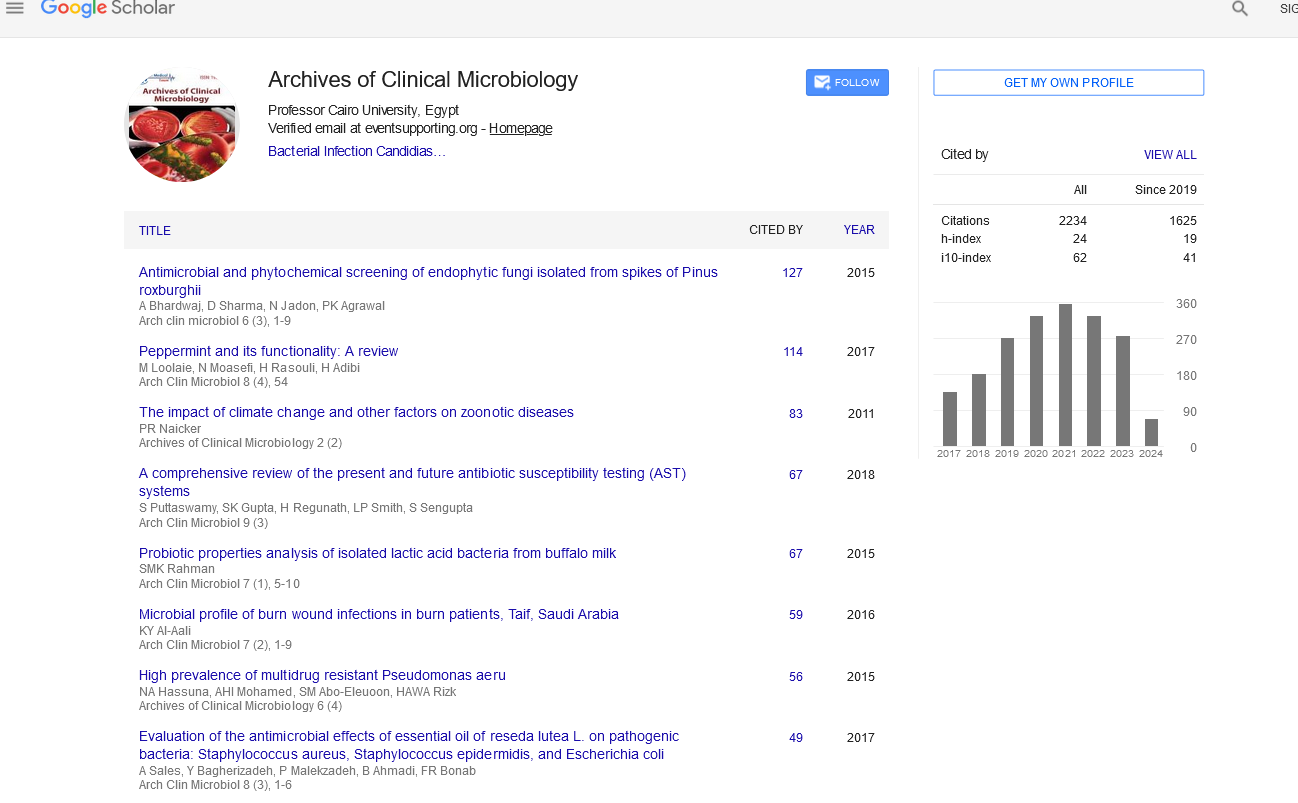Commentary - (2024) Volume 15, Issue 3
Understanding the Significance of Urine Culture in Clinical Microbiology
Maria Qvistgaard*
Department of Clinical and Experimental Medicine, Linkoping University Hospital, Linkoping, Sweden
*Correspondence:
Maria Qvistgaard, Department of Clinical and Experimental Medicine, Linkoping University Hospital, Linkoping,
Sweden,
Email:
Received: 23-Apr-2024, Manuscript No. IPACM-24-14780;
Editor assigned: 26-Apr-2024, Pre QC No. IPACM-24-14780 (PQ);
Reviewed: 10-May-2024, QC No. IPACM-24-14780 (QC);
Revised: 20-May-2024, Manuscript No. IPACM-24-14780 (R);
Published:
27-May-2024
Description
In the realm of clinical microbiology, urine culture stands as a vital diagnostic tool, particularly in the context of Urinary Tract Infections (UTIs). These infections, caused by various microorganisms, pose significant challenges to healthcare systems worldwide. For clinicians and microbiologists alike, a comprehensive understanding of urine culture's principles, methodologies, and clinical implications is essential. This article aims to provide an in-depth exploration of urine culture, shedding light on its importance, procedural aspects, interpretation of results, clinical applications, and the challenges encountered in clinical practice.
Urine culture serves as the gold standard for diagnosing UTIs, offering invaluable insights into the microbial etiology and antimicrobial susceptibility patterns. Its primary objective is to identify the causative organism(s) responsible for the infection and determine their susceptibility to antibiotics, thereby guiding appropriate treatment strategies. Moreover, urine culture helps differentiate between true infections and contaminants, thereby preventing unnecessary antibiotic use and minimizing the risk of antimicrobial resistance.
Methodology of urine culture
The process of urine culture begins with the collection of a clean catch midstream urine sample to minimize contamination. This specimen is then inoculated onto specific culture media and incubated under optimal conditions to promote the growth of microorganisms. Various techniques, including quantitative and qualitative methods, may be employed to enumerate bacterial colonies and identify the predominant pathogens. Advances in technology, such as automated systems and molecular methods, have further enhanced the speed and accuracy of urine culture, allowing for rapid microbial identification and susceptibility testing.
Interpretation of results
Interpreting urine culture results requires careful consideration of several factors, including colony count, organism identification, and antimicrobial susceptibility testing. Significant bacteriuria, defined as the presence of a significant number of bacteria in the urine sample, is indicative of UTI. The identification of specific pathogens and their susceptibility to antibiotics is crucial for selecting appropriate antimicrobial therapy, taking into account local resistance patterns and patient-specific factors. Additionally, the presence of polymicrobial infections or unusual pathogens may necessitate further investigation and clinical correlation.
Clinical applications of urine culture
Beyond its role in diagnosing and treating UTIs, urine culture findings have broader clinical applications. Positive urine cultures may indicate underlying genitourinary abnormalities, such as kidney stones or structural anomalies, prompting additional diagnostic evaluations. In certain clinical scenarios, urine culture results may also influence the choice of prophylactic antibiotics for patients undergoing urological procedures or those at high risk for recurrent UTIs. Moreover, surveillance of antimicrobial resistance patterns based on urine culture data is essential for guiding empirical antibiotic therapy and antimicrobial stewardship initiatives.
Challenges in urine culture
Despite its utility, urine culture is not without challenges. Specimen contamination during collection or processing can lead to false-positive results, necessitating stringent adherence to collection protocols and laboratory techniques. The presence of mixed growth or polymicrobial infections can complicate result interpretation and treatment decisions, requiring careful clinical correlation. Additionally, the emergence of antimicrobial resistance poses significant challenges in selecting appropriate antibiotic therapy based on urine culture results, highlighting the importance of ongoing surveillance and antimicrobial stewardship efforts.
Urine culture plays a crucial role in clinical microbiology, providing essential diagnostic information for the management of UTIs and other genitourinary conditions. Its significance extends beyond the laboratory, impacting clinical decision making, antimicrobial stewardship practices, and patient outcomes. By understanding the principles and applications of urine culture, healthcare professionals can optimize the diagnosis and treatment of UTIs while minimizing the risks associated with antimicrobial overuse and resistance. Through continued research and collaboration, the field of clinical microbiology aims to further refine urine culture techniques and enhance their clinical utility in patient care.
Citation: Qvistgaard M (2024) Understanding the Significance of Urine Culture in Clinical Microbiology. Arch Clinic Microbio Vol:15 No:3





